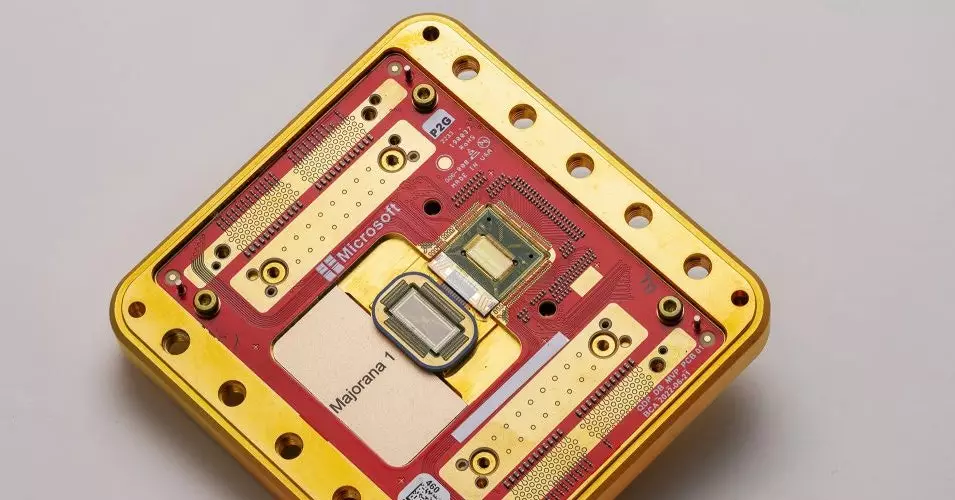Recent developments announced by Microsoft represent a significant advance in the realm of quantum computing: the creation of topological qubits. This innovation, rooted in the properties of exotic states of matter, not only promises to enhance computational power but could redefine what we understand about information processing in quantum systems. Microsoft’s Majorana 1 processor is designed to potentially house up to a million qubits, offering the capability to address some of the most ambitious goals in quantum technology, including the rapid decryption of information and the accelerated design of pharmaceutical compounds and advanced materials. While this development positions Microsoft ahead of competitors like IBM and Google, it is crucial to analyze the implications and limitations of these findings.
To fully grasp the importance of topological qubits, we should first understand the fundamental building blocks of quantum computing. Traditional computing utilizes bits as the smallest unit of data, functioning as a binary switch that represents either a ‘0’ or a ‘1’. In contrast, quantum computers rely on qubits, which leverage the principles of quantum mechanics. Qubits can exist simultaneously in a state of ‘0’ and ‘1’ due to superposition. This capability allows quantum computers to perform complex calculations at unprecedented speeds, particularly beneficial for tasks involving cryptography and simulating molecular interactions.
However, qubits are notoriously difficult to create and maintain. The very nature of quantum states makes them susceptible to disruption from external influences, leading to what is known as decoherence. Researchers have pursued various approaches to develop stable qubits, employing techniques such as trapping atoms or utilizing superconducting circuits. Microsoft’s strategy, centered around topological qubits, aims to solve some of these inherent challenges through the use of Majorana particles.
Majorana particles, theorized by the physicist Ettore Majorana in 1937, are of particular interest due to their unique properties. Unlike conventional particles such as electrons, Majoranas are quasi-particles that emerge in specific topological materials—topological superconductors. The key advantage of using such materials is that they offer an environment that can protect qubits from external interference. In theory, this shield can enable the qubits to maintain their quantum states for longer periods, significantly improving the reliability of quantum computations.
The transition from theory to practical application is fraught with complexity. While Microsoft’s claims are promising, the details remain partly unverified. The findings disseminated through their paper published in *Nature* hinted at a novel approach to quantum hardware, but without independent confirmation, the full potential of the Majorana 1 processor remains speculative. The researchers have also outlined a “road map” detailing the next steps in making these topological qubits operational, emphasizing that several challenges must be addressed before they can be fully realized.
The Road Ahead
While the news surrounding Microsoft’s advances in topological qubits is indeed exciting, it is prudent to maintain a critical perspective. The quantum landscape is anything but straightforward, with numerous hurdles still to overcome before these technologies can be successfully integrated into practical applications. Key challenges include refining the fabrication and cooling processes required for topological superconductors, ensuring the stability of Majorana particles, and establishing reliable methods for reading and writing data in this new qubit architecture.
In the broader context, the potential impact of successfully integrating topological qubits into quantum computing is monumental. Such breakthroughs could lead to advancements in fields ranging from secure communication networks to revolutionary drug discovery methods. Moreover, the competitive atmosphere among tech giants like Microsoft, IBM, and Google serves to drive innovation, ensuring that the pursuit of quantum supremacy is not only a scientific endeavor but also a race with significant economic implications.
Microsoft’s creation of topological qubits signifies a pivotal moment in the ongoing quest to harness the power of quantum computing. While challenges persist, the prospect of integrating Majorana particles into practical quantum processors offers a tantalizing glimpse into the future of information technology. As this field progresses, continued scrutiny and independent verification will be essential to ascertain whether these ambitious claims will translate into the concrete advancements that the world awaits. As researchers and developers push the boundaries of what’s possible, the implications of their work will undoubtedly shape our technological landscape for years to come.

